Question
1-With respect to the recognition of goodwill in a business combination, which of the following statements is true? a)Only US GAAP requires recognition of goodwill
1-With respect to the recognition of goodwill in a business combination, which of the following statements is true?
a)Only US GAAP requires recognition of goodwill when the fair value of the consideration transferred exceeds the net fair value of assets and liabilities. b)US GAAP standards require goodwill to be allocated to reporting units expected to benefit from the goodwill c)Only IFRS standards require annual assessments for goodwill impairment. d)IFRS requires a reporting units implied fair value for goodwill to be calculated as the excess of such units fair value over the fair value of its identifiable net assets. e) Neither US GAAP, nor IFRS, provide that goodwill impairments will not be recoverable once recognized.
2-A parent company owns a controlling interest in a subsidiary and on the last day of the year, the subsidiary issues new shares entirely to outside parties at $33 per share. The parent still holds control over the subsidiary. The adjusted subsidiary value at the date of the new stock issuance was $27 per share. Which of the following statements is true? a-Since the sale was made at the end of the year, the parent's investment account is not affected. b-Since the shares were sold for more than the adjusted subsidiary value per share, the parents investment account must be increased. c-Since the shares were sold for more than the adjusted subsidiary value per share, the parents investment account must be decreased.
d-Since the shares were sold for more than the adjusted subsidiary value per share, but the parent did not buy any of the shares, the parents investment account is not affected. e-None of these answer choices are correct.
3-Which of the following statements regarding consolidation of a VIE with its primary beneficiary is true?
a-The consolidation of a VIE with its primary beneficiary requires the business enterprise to follow a separate process than the one required for consolidations based on voting interests.
b-All intra-entity transactions between the primary beneficiary and the VIE are included in the consolidation.
c-Only intra-entity transactions between the primary beneficiary and the VIE resulting from intra-entity transfers are eliminated in the consolidation.
d-VIEs with controlling interests must include one hundred percent of the primary beneficiarys net income in a consolidation.
e-The allocation of the VIEs net income is based on an analysis of the underlying contractual arrangements between the primary beneficiary and other holders of variable interests.
Step by Step Solution
There are 3 Steps involved in it
Step: 1

Get Instant Access to Expert-Tailored Solutions
See step-by-step solutions with expert insights and AI powered tools for academic success
Step: 2

Step: 3

Ace Your Homework with AI
Get the answers you need in no time with our AI-driven, step-by-step assistance
Get Started


